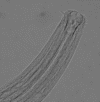Subfamily
Oncholaimellinae
Revised
03/09/24
Nematoda
Enoplea
Enoplia
Enoplida
Oncholaimina
Oncholaimoidea
Oncholaimidae
Oncholaimellinae De Coninck, 1965
Free-living marine nematodes. Several species reported from coastal mangrove
swamps.
The Oncholimellinae is on of seven subfamilies of the Oncholaimidae
(Adoncholaiminae, Krampiinae, Octonchinae, Oncholaimellinae, Oncholaiminae,
Pelagonematinae and Pontonematinae), differentiated by features such as the
number and length of teeth, the position of the largest tooth, the structure of
the female reproductive system, and the presence and development of the Demanian
system (Smol & Coomans, 2006; Smol et al., 2014).
The Oncholaimellinae has general characteristics of the family Oncholaimidae:
- Free-living marine nematodes
- Lips usually fused..
- Large cylindrical buccal cavity, usually with 3 immovable teeth of
unequal size surounded in the posterior region by esophageal tissue
- Esophageal glamds open through the teeth.
- Amphidial fovea pocket-shaped, posterior to buccal cavity.
- Esophagus muscular throughout length, esophageal gland openings just
posterior to buccal cavity.
- Males mainly diorchic, spicules varied in shape and size; gubernavulum
present or absent.
- Females didelphic amphidelphiuc or monodelphic prodelphic; ovaries
reflexed.
Specific characteristsics of the subfamily Oncholaimellinae:
- Right ventrosublateral tooth larger than the other teeth
- Demanian system simple if present
The Demanian system is a set of canals, junctions and pores unique
for some genera of Oncholaimidae. The system differs from simple
(primitive) to more complex (advanced) in different genera and species.
The Demanian system features in "traumatic insemination" in which
the male uses spicules and secretions to puncture the cuticle of the
posterior of the female to form a copulatory pore. Sperm are released
into the pore. The sperm injected into the female move through terminal
ducts and reach the main duct of the Demanian system. The sperm move
forward in the main duct to the uterus through the uvette and ductus
uterinus. Eggs are fetrilized in the uterus ( Coomans et al., 1988;
Tchesunov, 2015).
|

Oncholaomidae - anterior |
Ref: Neres, et al., 2014; Smol and Coomans, 2006; Smol, et al., 2014.
Return to
Oncholaimidae Menu
References
Coomans, A., Verschuren, D., Vanderhaeghen, R. 1988. The demanian system,
traumatic insemination and reproductive strategy in Oncholaimus oxyuris
Ditlevsen (Nematoda, Oncholaimina). Zool Scr 17:15-23.
Neres, P.F., Da Silva, M.C., Miranda-Junior, G.V., Fonseca-Genevois, V., Esteves,
A.M. 2014. Five new species of Oncholaimellus (Oncholaimidae: Nematoda) from
north-east Brazil, with an emended diagnosis and an updated key to the genus .
J. Marine Biol, Assoc. UK 94:703-727.
Smol N. and Coomans A. 2006. Order Enoplida. In Eyualem-Abebe Traunspurger W.
and Andrassy I. (eds) Freshwater nematodes: ecology and taxonomy. Wallingford,
UK: CABI Publishing, pp. 225–292.
Smol, N., Muthumbi, A., Sharma, J. 2014. Order Enoplida, 7.3. In
Schmidt-Rhaesa, A. (ed) Handbook of Zoology. De Gruyter, Berlin
Tchesunov, A.V. 2015. Free-living nematode species
(Nematoda) in hydrothermal sites of the North Mid-Atlantic Ridge. Helgoland
Marine Research 69:343-384.
Go to Nemaplex
Main Menu
